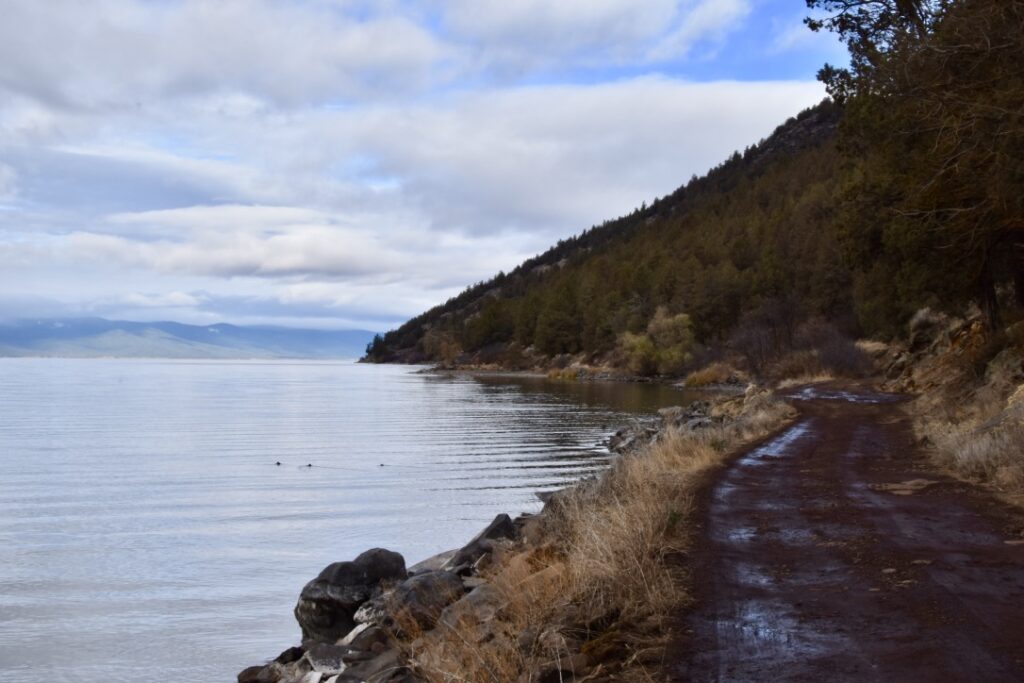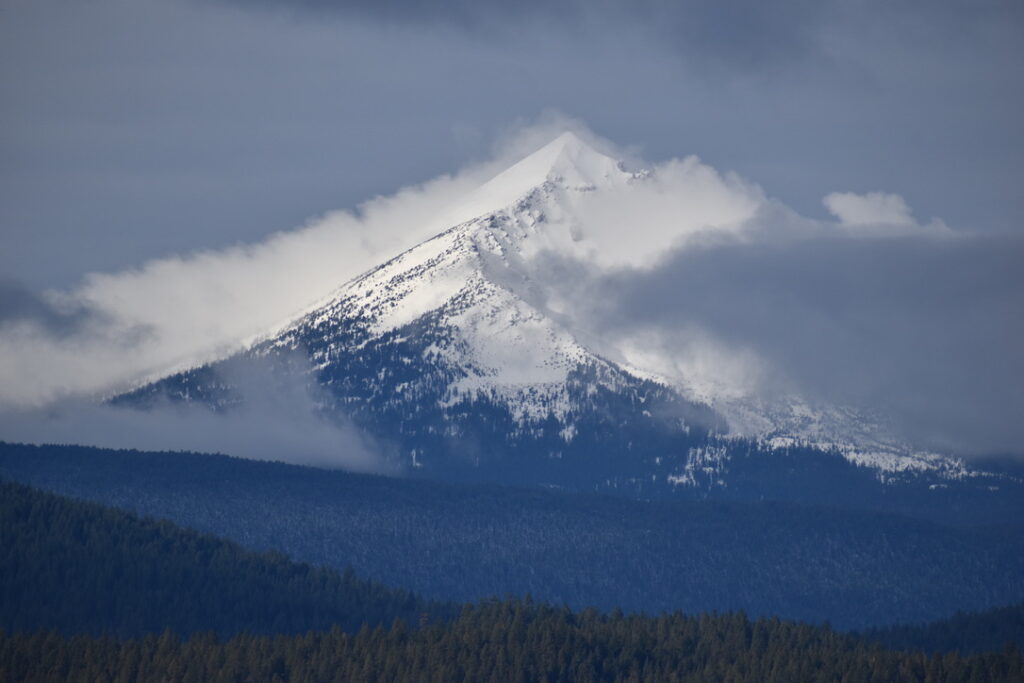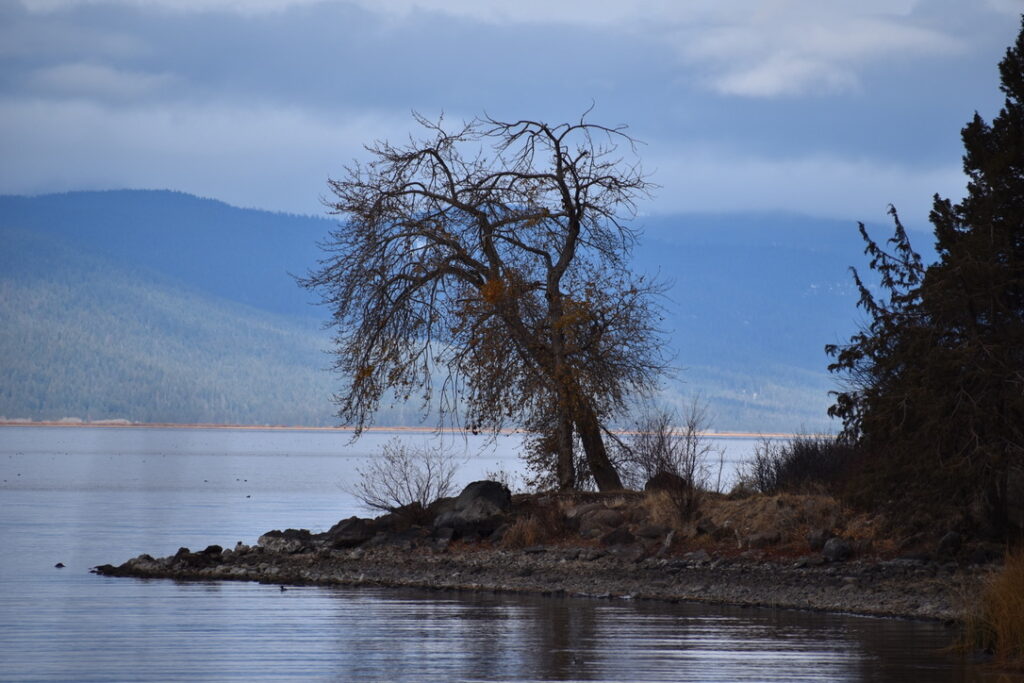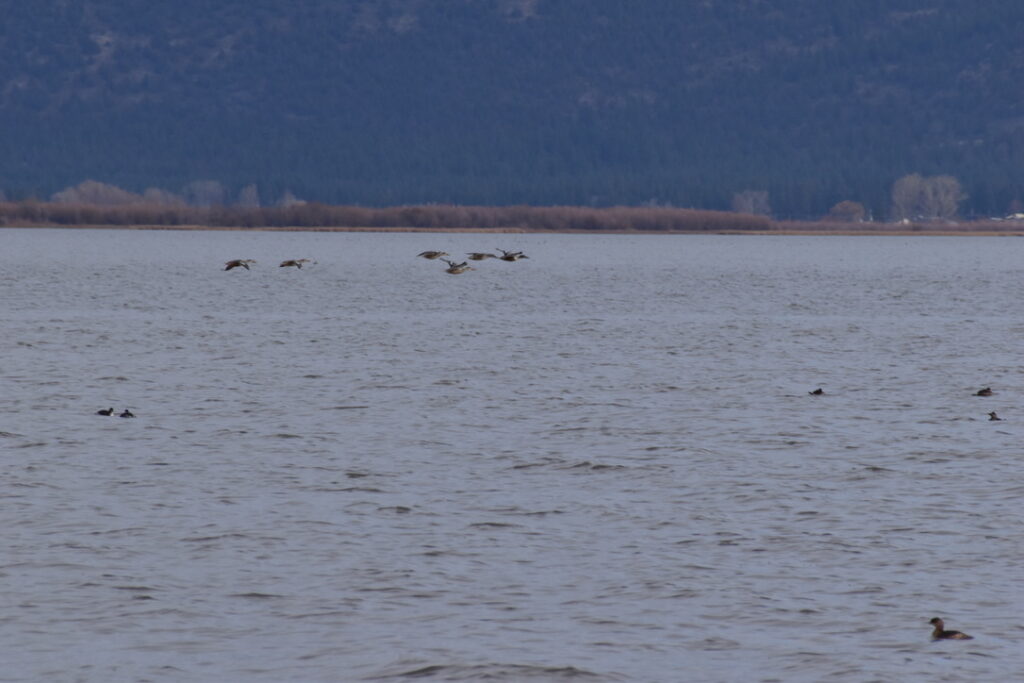
The guttural thrum of a diesel engine, muffled by shoreside trees, wafts across Upper Klamath Lake. Though it permeates my present locale, the engine is a small sound in these spacious shores, and leaves room for others, such as my footsteps on this dirt road, and the flapping of loons, scattering from the shore at my approach. A dog barks as I near the idling diesel truck, and his human companion, who had been engrossed in hooking a lure, looks up from his tackle box and acknowledges me with a nod.
Today I am in Oregon, exploring the northern reaches of the Klamath Basin. I drove up from Klamath Falls, turned off down a series of dirt roads that seemed to want to draw me in, found myself on a peninsula that google maps told me is called Eagle Point, and when the roads became too rutted and filled with icy puddles to take my car, I continued on foot.
In my head are echoes of electric-pop duo Sylvan Esso, one of my favorites. “It’s a ring I’m running, round and round,” Amelia Meath intones, round and round inside my head. Nick Sanborn’s synthesizers pulse and thrum like a diesel engine. The counterpoint between natural and synthetic is reflected in the external soundscape of the lake, and in my mind they all collide together: internal, external, natural, synthetic. As I think about right living, about a sustainable place for humanity within the natural world, it seems to me today that these opposites and the tensions they create are not mutually exclusive, that there might be a way we can hold them all in a productive tension. It seems to me that Upper Klamath Lake might be a key to that productive tension in this region.
The lake is murky, which gives the sun a dull glint off the surface. Much brighter are the clouds streaming from cap of Mt. McLoughlin, the snow-covered stratovolcano that asserts itself high above the forests on the far side of the lake. They seem colorfully white, hale and healthy as if every hue of the rainbow is so fully and purely expressed within a single sweep of light that the eye is overwhelmed by color and resolves it with white.

As I tread along the lakeside road, a hawk protests my presence with an upset cry. It pulls me further into the external, and my casting eyes land on a green aluminum can impaled on a tree branch up the slope. I cringe, embarrassed for my species. I consider going to retrieve it, but the tangle of bushes is too thick to pass without damage. Besides, litter is hardly the biggest problem facing this lake.
As recently as eleven thousand years ago, Upper Klamath Lake formed a continuous body of water with Tulelake and Lower Klamath Lake. At over a thousand square miles, the freshwater sea was more than three times the size of the Salton Sea in southern California. Today at only 96 square miles, Upper Klamath Lake is still the largest lake in Oregon, and provides most of the water storage for the Bureau of Reclamation’s Klamath Project. Over-allocation of water rights means that most of the water is siphoned off for irrigation projects and the lake sits at persistently low levels. Low water means warmer water and concentrated nitrogen, which means algae blooms, which leads to dangerous toxins. The result is the death of fish and other species that depended on the balance of the ecosystem.
Two fish species of particular concern right now are the Lost River Sucker and the Short-Nosed Sucker. These fish used to arrive by the tens of millions, and provided food for the Klamath Tribes and other settlers to the region. The C’waam and Koptu, as the Klamath tribes call them, have declined in population by more than 99%.
The road climbs away from the lake. Two bald eagles take to the air, disturbed by my passage, and fly out across the lake. I stop my walk to watch the graceful duet they weave against the wide open sky. The far shore to the north is carpeted with green forest, and a thin plume of smoke emerges from a spot a few hundred feet up the slope.

Some argue that it’s nonsense that we should upend our farming practices in order to protect just a few species of fish, but they fail to see the connection to the larger systems that these fish represent. In this case, they are part of a message about the nitrogen cycles that are essential to all life. Nitrogen is an essential building block of amino acids, which in turn make up the proteins for all living creatures, plant and animal alike. The unnatural concentrations that lead to toxic algae blooms are a sign that the cycle is significantly out of balance. The fish are simply the first casualty and harbinger of a much larger problem. The Klamath creation story includes a phrase that serves as both warning and prophecy: “If the C’waam go away, the people go away.”
After a climb away from the lake, the road loops back on itself, and at the far end a use trail descends over a promontory toward an eastern view of the lake. I follow it down between close-knit bushes to a rocky promenade at the shore. A few grebes swim away at my approach, but they seem unconcerned by my presence here. On the distant eastern shore, a highway carries people and goods speeding north and south. There are so many cars and trucks in an endless stream. I wonder about the motivations for all these trips. I’m sure each of them seems well-considered to the drivers and passengers within, just as my trip out here for a walk through the woods seemed important to me, but is it possible that some of these trips could be dispensed with? How much of our culture is a house of cards, built upon its own flimsy foundation?
Wild geese fly by in short lines of threes and fours and sevens like loose threads floating in the wind. Nearly all of them are traveling southeast to northwest, as if they were making a beeline for Mt. McLoughlin, but a few of these loose threads fly in the opposite direction. I stand and watch for a long while, listening to the water lapping at the shore, the distant hum of the highway, and the quiet squawking of the geese. This rocky promenade, protected on one side by a steep, thickly vegetated slope and on the other by the murky water of the nitrogen-poisoned lake, provides a sort of island, disconnected from both civilization and nature.

We tend to think of human culture, materialist culture, as all-encompassing. It infects our thoughts and our actions so completely that we often find ourselves thinking about it even when we don’t intend to. I remember back to a path near my home, where it seemed every overheard conversation was about jobs, money, or purchases. It’s an obsessive form of thinking that limits the scope of our solutions. In some traditions of meditation, thoughts are examined as if they are clouds in a wide open blue sky. This larger awareness allows us to look at the thoughts apart from ourselves, and they lose some of their power over us. I wonder how we might take a similar view toward materialism and human exceptionalism. Looked at through the larger lens of the non-human world, humans have created a culture that is useful but out-of-control.
There is a place for human science and industry, but it cannot be everything, and we cannot naively assume that they are the only answers to the problems that they themselves have created, and which some of our temporary “solutions” have exacerbated. In some cases, we will need to take a step back and allow the ecological systems that developed over thousands and even millions of years to heal themselves. In the end, I don’t think the decision will be all that difficult to make, but it will first require that we step back from our obsession with material culture, and allow for a culture and a way of thinking that recognizes the interconnectivity between our human-centered practices, whether for farming or for fuel or just for fun, and the larger cycles that they exist within.
When fixate on the internal, external, natural, or artificial, and fail to see how they relate to one another on a larger scale, we operate from too small a space for useful solutions to emerge, and often look for human-centered solutions. When we bring in fertilizer to make up for the lack of nutrients in the soil, we’ve fallen prey to a human-centered solution. When we myopically focus on technological improvements and green energy solutions, we accidentally drive down the cost of fossil fuels, which then increases their rate of use. If a holistic view is too much for our human minds to comprehend, we should trust the harbingers, like the C’waam or the Bald Eagle, to help us keep track of the health of the systems they inhabit.
When I finally pull myself away from the lake and start the walk back to my car, the synth-pop beats of Sylvan Esso are still running through my head, round and round. A hawk cries plaintively from somewhere above the trees. I stop along the way to talk to some fisherman, who share a story about a bear they saw swimming in the lake last year as they motored across in a small boat to go fishing. And then I return to my car, fire up the gas-powered engine, turn on the radio, take a pull of purified water from my waterbottle, roll down the windows to let in the air, and drive away, my thoughts colliding against the music.
Hi Nick, your writing makes me want to plan a trip to Oregon. I really look forward to you guys coming to Bisbee. Hugs for the girls. Ron